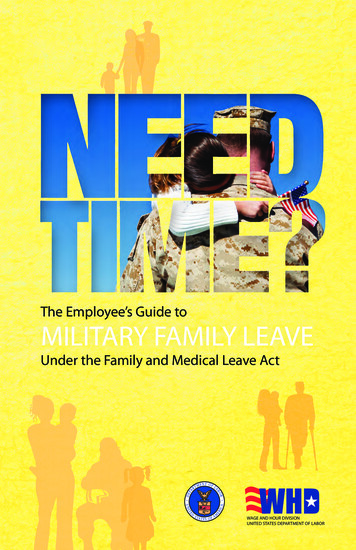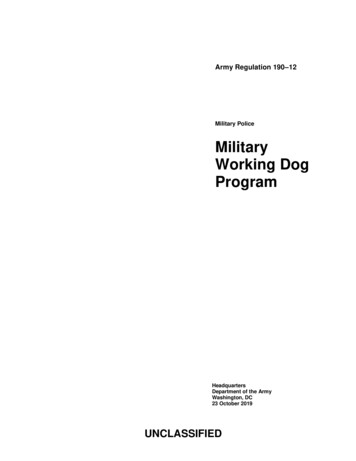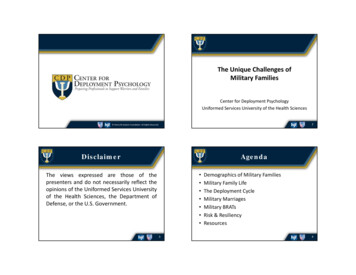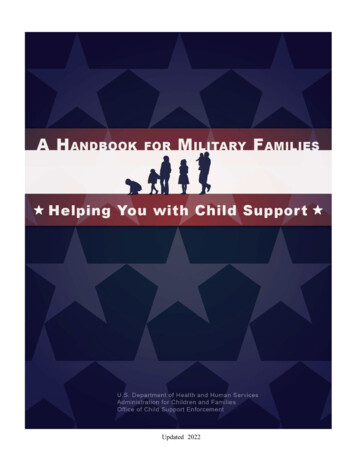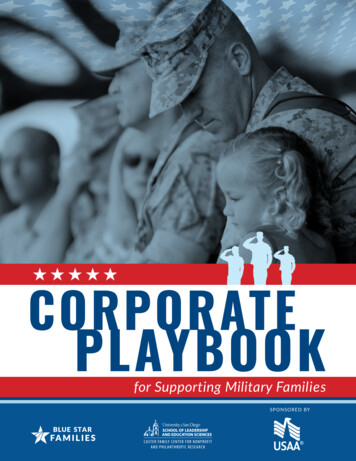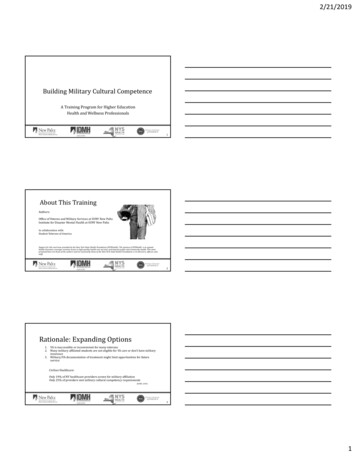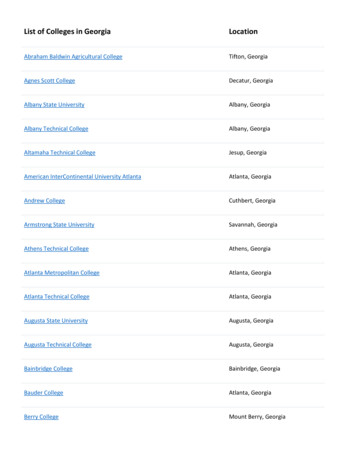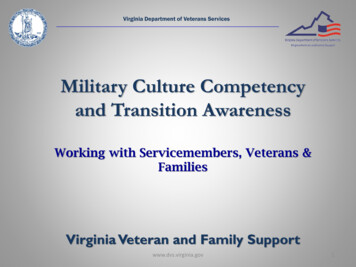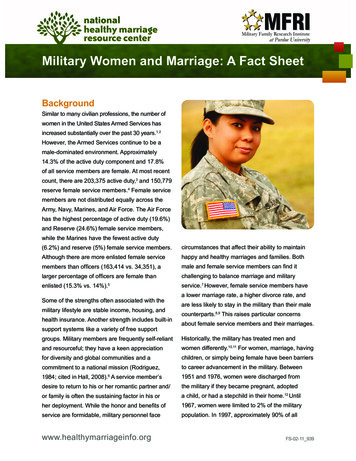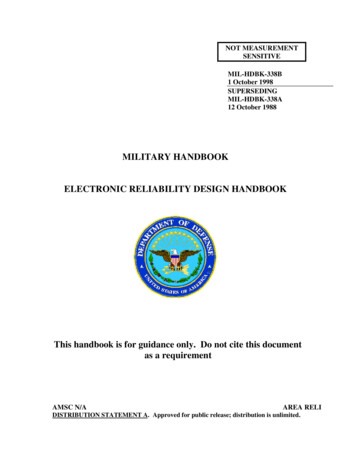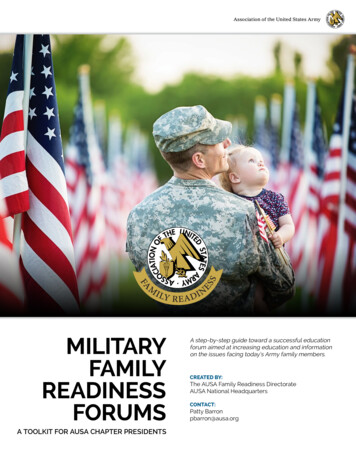
Transcription
Association of the United States ArmyMILITARYFAMILYREADINESSFORUMSA TOOLKIT FOR AUSA CHAPTER PRESIDENTSA step-by-step guide toward a successful educationforum aimed at increasing education and informationon the issues facing today’s Army family members.CREATED BY:The AUSA Family Readiness DirectorateAUSA National HeadquartersCONTACT:Patty Barronpbarron@ausa.org
3Welcome4Part I: Event Planning4Getting Started Gauging Your Local Community Needs Topic Selection Determining the Date, Location andLength of Forum7Budget8Program Partner Selection Community Partner Exhibit Fair Optionsand Passport Participation8Marketing the Event9Determining and Managing Speakers Inviting Speakers and Panelists Pre-Forum Conference Calls Invitation and Registration Set-Up Inviting Senior Leaders and Influencers11Part II: Event Execution11Administration for the Event The Venue Point-of-Contact and Caterer Audio/Visual Requirements Room Set-Up Registration Table Set-Up Promotional Items and Give-Aways13Part III: Event Follow-Up13Event Survey and After Action Review (AAR)13Thank Speakers, Panelists and Volunteers14Appendix2
Dear AUSA Chapters,On behalf of the Association of the United States Army (AUSA) Family Readiness Directorate, we are thrilledthat you have volunteered your chapter leaders, members, resources and time to provide an educational forumto the military families in your local community and/or those that support them. This toolkit is meant tosupport you in this endeavor. It was written with the novice in mind (thus the large amount of detail) but wehope that those of you with more experience will also find portions of it helpful.Each year during the AUSA Annual Meeting in Washington, D.C., the Military Family Forums showcase aseries of topics pertinent to current issues that impact Army families. In 2015, AUSA took its popular MilitaryFamily Forums on the road to address issues and concerns specific to the Regular Army, Army National Guardand Army Reserve families across the nation. Now, the AUSA Family Readiness Directorate looks to you, ourlocal Chapters, to support this national effort in your own communities.All AUSA Military Family Forums aim to provide Army families—and the organizations that support them—with education, information and networking opportunities to help all participants recognize and master thedifferent phases of the military life cycle.Our expected outcomes include: providing a better understanding of the current status of local installationand community-based programs specific to topics of discussion; and affording an opportunity to network withorganizations focused on military families and family members.All Military Family Forums strive to bring in the most qualified and informed subject-matter experts for eachevent. For example, when the AUSA Family Readiness Directorate hosted a forum at Joint Base Lewis–McChord(JBLM), Education for the Entire Family, speakers for the program included representatives from the Departmentof Defense State Liaison Office; the Military Interstate Compact Commission; school superintendents; Veterans’Services representatives who serve in the Washington State Department of Veterans’ Affairs; and representativesfrom the David L. Stone Education Center at JBLM and Armed Forces Community Services.This Toolkit includes everything you and your chapter will need to arm yourself with building a successful Military Family Forum in your community.Thank you for your continued service to the All-Volunteer Force.Sincerely,Patricia M. BarronDirector, Family ReadinessAssociation of the United States Armypbarron@ausa.org3
PART IEVENTPLANNINGGETTING STARTEDMaking the decision to offer a Military Family Forum in your community can be daunting. There are manysteps that go into planning this impactful event. Where do you start? How do you know what to offer? Whoshould be involved?In our opinion, the best place to start is by forming a two-to-three person planning committee that will be dedicated to the planning and execution of the forum. Be strategic about the selection of these members and ensurethey have the necessary time and availability and are dedicated and passionate about serving the local militarycommunity. Members can include representatives from AUSA National Headquarters, the local AUSA Chapterand/or representation from the local Army Community Service (ACS) office. The planning committee shouldbegin working together approximately four to five months prior to the projected event date.Once the committee is established, gauge the local community to see what the most pressing needs are.GAUGING YOUR LOCAL COMMUNITY NEEDSWith 113 AUSA chapters worldwide, the local military communities with which you interact can be verydiverse. Many of you have a combination of Active and Reserve component units that make up your targetedaudience, all with specific needs for support and education. It is therefore important that you use various strategies to discover the specific issues and challenges faced by the families you serve. Send out a short survey to the members in your chapter asking them to identify what issuesthey are hearing from the Regular Army, Army National Guard and Army Reserve families inyour area. Sample survey questions could include:––If AUSA (Chapter Name) were to host an educational Military Family Forum in thisarea for local military families, what types of topics should we consider?––Besides local military family members, whom else should we invite?––Have you been in contact with or heard a speaker at any event within the past 12months that really piqued your interest and could send an impactful and motivational message to our local military and/or surrounding community?––Are there topics concerning military family issues that you think our corporatemembers would be interested in learning more about?––Would you be interested in assisting with the planning and execution of a MilitaryFamily Forum in our community?4
Survey Monkey is an easy-to-use online tool that can help you gather answers to thesequestions. You can access it for free by clicking here.Consider forming a focus group of like-minded AUSA Corporate Members in order to gaugetheir interest and knowledge on topics concerning the military community and military needs.Possible topics might be: Healthcare Professionals: Military families and PTSD; Large/National/Multinational Corporations: How to Hire and Retain a Military Spousethrough Permanent Change of Station (PCS) Moves; and Small Businesses: Get to Know Your Military NeighborsBased on your location, are there any topics that might catch the eye of current and potentialcorporate members? Contemplate hosting a breakfast or light lunch and invite the senior leaders or spouses to aninformation collection session. Inquire about their family needs and ask what they are hearingfrom their local units. If you have access to the Army Community Service Staff, inquire what the top concern is tomilitary families who visit their office. Also, see if there is a way to collaborate on the Military Family Readiness Forum in case you want to incorporate installation resources into yourforum. If you have a connection to the Army National Guard or an Army Reserve family programsrepresentative, inquire how you can integrate their needs—as well as the needs of the RegularArmy—into the Military Family Readiness Forum.TOPIC SELECTIONOnce the immediate needs of the community are clear, it is time to select your Military Family Forum Topic.At AUSA National Headquarters, we have found that the top issues facing military families include: Military Spouse Employment and Licensing. A Military Family Forum that supports a military spouse’s quest to develop portable careers and learn how to hunt for a job no matter wheretheir family is stationed is always very timely. Local representatives from the Department ofLabor Workforce Center, Employment Resource Centers, the Readiness Program managerfrom the installation and the Small Business Development center could be among the speakers and panelists. More information on military spouse employment can be found by clickinghere. Financial Readiness. Given the looming change to the military retirement system, a forumthat highlights financial readiness also might be well-received in your community. Particulartopics might be: an overview of the economic health of the community; trusted sources for financial education; how to prevent getting trapped by pay day lenders; and assistance providedby the Financial Readiness office under Army Community Service. Ideas for specific topics onFinancial Readiness can be found by clicking here. Military Caregiver Support. In their report, Hidden Heroes: America’s Military Caregivers, theRAND corporation estimates “there are 5.5 million military caregivers in the United Sates. Ofthese, 19.6 percent (1.1 million) are caring for someone who served in the military after theterrorists attacks of September 11, 2001.” The need to support these caregivers is great. This forum works best if your target audience is the community at large. Educate participants on the5
needs of our caregivers and provide the caregivers and wounded warriors in your communitya platform to tell their story. More information on military caregivers can be found by clickinghere. Military Family Education. A forum dedicated to the education, experiences and opportunities available to military children, spouses and Soldiers could provide a plethora of speakers and topics. Speakers could include superintendents from the various school districtssurrounding military installations, the state Military Interstate Compact Commissioner, arepresentative from the Governor’s Office of Public Instruction, a representative from aninstallation Continuing Education Office, the Financial readiness Program Manager, the officeof Veterans’ Services or the Transition Education Counselor. Our suggestion would be to workclosely with your local school liaison officer (SLO). Networking Forums for Reserve Component Spouses. We have found when creating forumsfor our Reserve Component family members that their number one issue is how to find andnetwork with each other. A forum that highlights using social media platforms for networking,Family Readiness Groups for information sharing and that demonstrates connections to theFamily Assistance Centers might be a very successful event. Keep your expectations in check.Remember that geographically dispersed family members cannot always gather in one location. Experiment with a Facebook Event or Facebook Live. Make it fun and innovative! Working with Mid-Deployment Yellow Ribbon Events. If you have a good relationship withthe State National Guard Yellow Ribbon Program Director, you might inquire about supporting their mid-deployment Yellow Ribbon Events. These events usually focus on reintegrationafter a long deployment. Perhaps there are experts among your corporate members who canprovide a two-hour workshop on how to reconnect after long absences. Military Family 101 for parents of New Soldiers and Officers or for Corporate MembersNew to Supporting the Military Community. Perhaps one of the most frequent requests thatwe get for information is from parents of new Soldiers. Many do not have a military connection and the world their child has just entered is completely foreign to them. Consider hostinga light breakfast with a short “Military 101” presentation and a longer time for Q&A. Parentswould love this and be so appreciative! Ask them to join AUSA and follow your Facebook pagefor further engagement and information. As for corporate members, many want to do whatthey can to support their local military community but might not know who or what constitutes a military family. A short 60–90-minute forum on military life and culture would beincredibly well-received and appreciated.DETERMINING THE DATE, LOCATION AND LENGTH OF FORUMSelecting a date is not as easy as one might think. It is imperative that you conduct research on activities occurring on the nearest installation(s) or with the Family Assistance Centers at National Guard Armories andReserve units to ensure there are no conflicts in topics, times and dates.If your target audience is stay-at-home military moms, then hosting a forum during the school calendar yearmay increase participation as school-age children will typically be occupied during the day. Check with the local schools to inquire if there is an early release on any specific days. In this case, avoid hosting on those specificdays. If you host an event during the summer and you are inviting military family members, child care or youthactivities can be an issue and should be considered in the planning process.If your planning committee wants to target an event for working professionals, you should consider offeringthe forum early in the morning—perhaps as a breakfast event, a brief lunch or potentially an evening dinnerwith a keynote speaker. Make sure you leave plenty of time to network, as networking is a main draw for young6
professionals. Setting aside 30–45 minutes of networking time just prior to the main talk would work nicely.Keep the speakers’ or panelists’ time to no more than 60 minutes, including Q&A.Location is key to driving a high attendance number. Holding the forums at your installation conference centeror National Guard Armory provides familiarity to local military family members and volunteers. However, sucha location could provide difficulties to attendees without military ID cards. Another option is to ask CorporateMembers about the availability of conference space at their office location(s). This could be an in-kind donationor contribution to the event. As you establish the location, inquire about the food and beverage menu options.This can assist in planning the event budget as well as helping you narrow down the list of potential venues;many venues might have restrictions on the types of food and beverages allowed on their premises.Based on the audience you are inviting, limiting the forum to two hours will generally provide strong attendance. It is probably a good idea to extend this time if you add an exhibit fair, but you are the best judge of whatyour community needs. Please find a sample event agenda of a previous AUSA Onsite Family Forum on page19. In addition, find the Family Forum Checklist on page 20 in order to consider all event planning aspectsbefore, during and after event.BUDGETAs you begin the planning process, ensure that you and your committee members set a budget you can workwith. Page 23 in the Appendix displays a sample budget. Your budget needs to include all aspects of the planning and execution process.There are several considerations you and your committee should take into account in planning the budget.Consider asking AUSA Corporate Members or community businesses for monetary and in-kind donationsor sponsorship. Example in-kind donations could include the donation of conference space, food, beverages,giveaways, gift cards for door prizes or table decorations. Page 24 in the Appendix is an example SponsorshipRequest Letter that should be tailored to your local community. Consider utilizing current Chapter funds and/or teaming up with other non-profit organizations in order to split program costs. In addition, do not forgetto inquire about volunteer assistance during the program. This is a great way for businesses with an employeevolunteer program to get involved.Finally, consider hosting a fundraising event to support the program costs. It could include raffles at all generalmembership meetings with proceeds going toward your Family Readiness Forum budget. Another effective option is a golf tournament. Those of you already in the business of conducting golf tournaments could designatea percentage of the proceeds to support your forum budget.In order to save money at your next forum, contemplate a few additional tips: request volunteer assistance; draw from internal resources including the Corporate Members, VIP Members and anyadditional organizations that you are associated with; shorten the event; consider serving coffee and pastries instead of a full meal; ask keynote speakers if they would be willing to donate their time to deliver their message(s); and negotiate with the venue point-of-contact about discounting services due to the AUSA nonprofit status.7
PROGRAM PARTNER SELECTIONAs mentioned previously, think about joining forces with other nonprofit organizations, installation services,higher education institutions and/or community partners in order to make a larger impact. Partner organizations can assist with program costs, fulfill volunteer needs, enable reaching a larger audience with the programmarketing materials and assist with program delivery.At AUSA National Headquarters, we team up with several organizations nationwide to deliver impactfulprogramming. Examples include the Young Professionals Program, the local Chambers of Commerce, theRed Cross, the Army National Guard YellowRibbon Program; Homefront United Network, the Department ofDefense Spouse Education and Career Opportunities initiative; Army Community Services; the Departmentof Veterans’ Affairs and National Guard Family Programs (depending on which state we host the event in); andFamily Readiness Group leaders. Please reference the Appendix, page 25, to view different samples of marketingmaterials that highlight the programs and partnerships AUSA National Headquarters has taken part in. TheFamily Readiness Directorate at the Headquarters is here to help. Please feel free to call us to brainstorm ideasor for contact information for some of the organizations’ national offices.COMMUNITY PARTNER EXHIBIT FAIR OPTIONS AND PASSPORT PARTICIPATIONA great way for forum participants to be acquainted with resources in the area is to invite local nonprofits,installation resources and community organizations who support military families to exhibit at a communitypartners’ exhibitors’ area. This exhibitor space can be in the entry-way to the conference area near registrationor on the wall perimeters inside of the conference space.To ensure participants are tapping into these resources, consider creating a participation passport to hand outat registration for each attendee to fill out as they visit each exhibitor. Once the passports are filled out, conducta drawing for a prize or give-away. Please reference the Appendix, page 26, for a sample Community ResourcesExhibit Fair Passport.In addition, feel free to share your pre-populated media kit (highlighted in the following section) with all participating exhibitors for further marketing outreach.MARKETING THE EVENTOnce you and your committee and/or program partner(s) have nailed down your date, time, location and forum topic, it is time to start building your marketing materials. If you do not have a graphic designer, you mightconsider going online and using a great assortment of marketing material templates. Many can be found at theCANVA website.Perhaps the most useful tool you can develop to publicize your event would be a media kit. Our media kittemplate, Media, was created to reach as many military families and organizations in your local communityas possible. Once you tailor this media kit to your upcoming event, determine who on your committee will bethe point of contact for any media inquiries. Create a list of organizations you and the committee would like toshare this with.If your target audience is military families, consider emailing your updated media kit to local military-affiliatednonprofit organizations, installation units or senior leadership, Family Readiness Groups, installation familyresources, etc. It can also be pushed to the Public Affairs Office to share with the on-installation media andoff-installation local media outlets, newspapers and news outlets. Please reference page 27 in the Appendix, for8
a sample media kit from the 2016 Hawaii Military Family Forum, Living with Posttraumatic Stress: An Updateon Issues and Resources.DETERMINING AND MANAGING SPEAKERSAfter the forum topic is selected, brainstorm, research and create a list of potential program speakers. It is always best to ask for their availability for the day. Be considerate of other people’s schedules, especially if they arevolunteering their time to support this event.Ask yourselves these questions: Will we need one keynote speaker and a follow-on panel? Who has heard this person(s) speak before? Are they well-suited for the topic at hand? Consider the following roles: The Master of Ceremonies: The Master of Ceremonies will kick off the program, introduce all of the speakers during the event and will keep the program moving on time.Look for someone who has an engaging personality and can keep the audience’s interest.Based on the program agenda, it is best that this speaker work with a script, even if it justoutlines basic biographies and a timeline. You can select someone who is serving on thecommittee or potentially reach out to news channel personalities in the local area whohave military affiliations. Keynote: If your event will host a keynote speaker, consider bringing in a person fromoutside the local area who has expertise and a broad reach for audience members. Youmight also consider someone who is local to your community and who works in a leadership role. Panel of Experts: If the forum will host a panel of subject matter experts or speakers,consider who will serve in these roles. Who will serve as the panel moderator? Limiting apanel to four people is best, as you do not want to overwhelm the audience with too manyspeakers. Additional speakers can often cause the program to run over the time allotted.If there is a way to incorporate the audience into the discussion with panel members, thiswould be best; audience interaction is generally very effective. When selecting representatives, consider adding representatives from the national program level, state program leveland the community and installation level. This will allow for a well-rounded discussion onwhat support services or programs are available. Timer: A firm timer is key to a successful forum. Introducing the timer to the speakerand panelists before the forum begins is essential. The timer should explain the process tothe participants and be placed in the front row of the seating area so that he or she can beeasily spotted and followed. Sponsor Recognition: If your forum has specific sponsors, consider giving them a shortspeaking role or recognizing them throughout the event program in the script of the Master of Ceremonies. Showing appreciation to the sponsors is always welcomed.INVITING SPEAKERS AND PANELISTSWe have found that the best way to ensure you get a good response to your speaker/panelist invitation(s) is todo an exploratory email or phone call first. See page 32 in the Appendix for a sample e-mail. Start with someone9
on the committee who might know the potential speaker and ask if they could reach out. If the prospectivespeakers seem amicable to participating, then follow up with an official letter of invitation. See page 34 in theAppendix for a sample letter.Once the speakers are selected, invited and confirmed, request their headshots, short bios and potentially theircontact information for your event program and Master of Ceremonies script. This will help the audience toidentify with each speaker and give them specific resources into the community.PRE-FORUM CONFERENCE CALLSSince the planning of this event starts several months ahead of the event date, scheduling a pre-forum conference call with all participating representatives and speakers is essential. For best results use a doodle poll tohelp with scheduling and make sure that you have an agenda when making the call. Page 33 of the Appendixprovides you with a sample agenda.INVITATION AND REGISTRATION SET-UPTo ensure that the event has a smooth registration process, a central registration site that includes pertinent details of the Military Family Forum should be created. One option to host a free, user-friendly virtual registrationprocess is a Facebook Event Page. For a more formal process, consider using Eventbrite. Ask around beforeyou decide what method to use. How are family members and organizations in your area registering for otherevents? Use what is familiar to your intended audience for best results.Potential questions for the registration site include: first name; last name; e-mail address; family member (Y/N);military affiliation (Regular Army, Army National Guard or Army Reserve); support services organizationname; and AUSA member status.Once the registration site has been built, it is best to launch the site to the public approximately 30 days beforethe event. Ensure that you include the registration link in the event Media Kit so that potential attendees knowhow and where to sign up.Also, consider how you will create name tags for the registered attendees. Will you create a list of participants’names and print them off on name tag cards with clear plastic card holders, write or print the names on specificname tag stickers or ask each attendee to create their own name tag as the arrive to the event venue? Keep inmind that the last option will cause a delay in on-site event registration.Finally, a good rule of thumb is to consider a 20–25 percent attendance drop off or “no-shows” on the day onthe event. This should assist with your overall head count.INVITING SENIOR LEADERS AND INFLUENCERSInviting senior leadership and senior spouses is essential to the success of your forum. Even if they cannot attend, making them aware of your event and perhaps getting them to help spread the word among their subordinates and family members could make a huge difference. Nothing fills seats like command interest. The invitation, along with the program flyer, should be sent from the most senior person within your chapter. If yourcommittee is considering extending this invitation, please reference page 31 in the Appendix for a template.10
PART IIEVENTEXECUTIONADMINISTRATION FOR THE EVENTBased on the committee members’ preference, determine who is going to be the lead administrator for the dayof the event. Their responsibilities will include arriving early to the event space to work with the location eventcoordinator, making sure that the exhibit hall and conference space are set up appropriately, running the speaker and program timeline, ensuring that the food and beverages are set up at the correct time and being the mainpoint-of-contact for any questions that come up.THE VENUE POINT-OF-CONTACT AND CATEREROnce the location is locked down, ensure that you are in communication with the venue point-of-contact on aregular basis. Important updates to discuss are the catering options, AV requirements and the conference spaceset-up.AUDIO/VISUAL REQUIREMENTSRegarding AV requirements, consider how large the event space is. Will your forum need a projector, microphones, speakers, a stage and/or a podium? If it is a smaller space, potentially consider using a projector andpodium. Based on the conference space, discuss the AV requirements with the venue point-of-contact as he orshe will have a good idea of what is needed for the space. Keep in mind that the more robust your AV requirements are, the higher the event costs will be.ROOM SET-UPConsider the set-up of the room and what will work best for your forum. Do you want round tables in orderto create dialogue between attendees, crescent moons (which work best for filling up the space when you havea smaller audience) or theater-style, which allows the attendees to face forward to the speakers, but does notallow for much conversation?If the conference space tables need linens, inquire about the costs, color and sizes. Will you need center piecesand/or specific types of chairs? Your venue coordinator should be able to assist with these decisions.Include the exhibitor area in this discussion. As stated previously, consider if you would like these exhibit tablesin the conference space, entry hallway or in an additional space.REGISTRATION TABLE SET-UPRequest two volunteers to man the registration table. This table should display name tags, program agendas andany additional “swag” or gifts for the attendees. It should be prominent when an attendee walks through thedoor.11
PROMOTIONAL ITEMS AND GIVE-AWAYSIf you are considering gifting AUSA promotional items to the families in attendance, feel free to place an inquiry through to the Family Readiness Directorate to request specific items. In addition to AUSA’s membershipbrochure, the following items can be sent to you for your specific event: family readiness folder; Sesame Streetcoloring books; ribbon paper clips; nail files; luggage tags; and assorted AUSA paraphernalia.Please reference the Sponsorship Request Letter Template on page 24 in the Appendix to request in-kind donations from local businesses. This is a great way to increase attendance and participation.12
PART IIIEVENTFOLLOW-UPEVENT SURVEY AND AFTER ACTION REVIEW (AAR)Following the event, it is best to send an event survey to all forum attendees within one week. This will assist ingaining feedback, will give your committee additional recommendations for future events and will potentiallyalert you to other needs in the community. Consider planning an AAR with your committee as well to discussthoughts and recommendations and review participant feedback. Please reference page 36 of the Appendix for asample Event Survey.We have found that Survey Monkey can be very helpful. It is easy to use and can be as basic or analytical as youchoose.Once all of the participant feedback is collected and the committee has had an opportunity to discuss the eventas a group, please type up and e-mail lessons learned to the Dir
series of topics pertinent to current issues that impact Army families. In 2015, AUSA took its popular Military Family Forums on the road to address issues and concerns specific to the Regular Army, Army National Guard and Army Reserve families across the nation. Now, the AUSA Family Readiness Directorate looks to you, our
